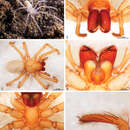en
names in breadcrumbs


The spider family Ctenidae (wandering spiders) includes 490 described species (Platnick 2013). Members of this family are two-clawed lycosoid spiders with a distinctive eye arrangement: the eight eyes are arranged in three rows, with the pair of small anterior lateral eyes positioned far back in a middle row with the large posterior median eyes, and the large posterior lateral eyes just behind these. Ctenids often have a median stripe running down the back. The family is a mainly tropical group, with just eight species known to range north of Mexico, occurring from the southeastern United States west to Texas (and two of these species are introduced). (Ubick and Silva Dávila 2005; Bradley 2013) Some South American ctenids are dangerously venomous to humans. One ctenid species, Cupiennius salei, has been the subject of extensive investigations of sensory physiology and behavior. (Bradley 2013).
Ctenids are large nocturnal wandering hunters. Although some tropical species are arboreal and hunt on vegetation, all Nearctic species are strictly terrestrial. They may be collected at night using headlamps, under rocks and logs, and occasionally in caves. Egg sacs are either deposited on the substrate or carried with the chelicerae (Dippenaar-Schoeman and Jocqué 1997 cited in Ubick and Silva Dávila 2005). Occasionally, species of Acanthoctenus, Cupiennius, and Phoneutria are inadvertently transported with shipments of tropical fruits. Silva Dávila (2003) and Ubick and Silva Dávila 2005 (2005) review the complex and somewhat controversial taxonomic history of the Ctenidae. (Ubick and Silva Dávila 2005)
Wandering spiders (Ctenidae) are a family of spiders that includes the Brazilian wandering spiders. These spiders have a distinctive longitudinal groove on the top-rear of their oval carapace similar to those of the Amaurobiidae.[1] They are highly defensive[2] and venomous nocturnal hunters. Wandering spiders are known to hunt large prey, for example hylid species Dendropsophus branneri.[3] Despite their notoriety for being dangerous, only a few members of Phoneutria have venom known to be hazardous to humans, but the venoms of this family are poorly known,[4] so all larger ctenids should be treated with caution.
As of July 2021, the World Spider Catalog accepts the following genera:[5]
{{cite web}}: CS1 maint: url-status (link) Wandering spiders (Ctenidae) are a family of spiders that includes the Brazilian wandering spiders. These spiders have a distinctive longitudinal groove on the top-rear of their oval carapace similar to those of the Amaurobiidae. They are highly defensive and venomous nocturnal hunters. Wandering spiders are known to hunt large prey, for example hylid species Dendropsophus branneri. Despite their notoriety for being dangerous, only a few members of Phoneutria have venom known to be hazardous to humans, but the venoms of this family are poorly known, so all larger ctenids should be treated with caution.